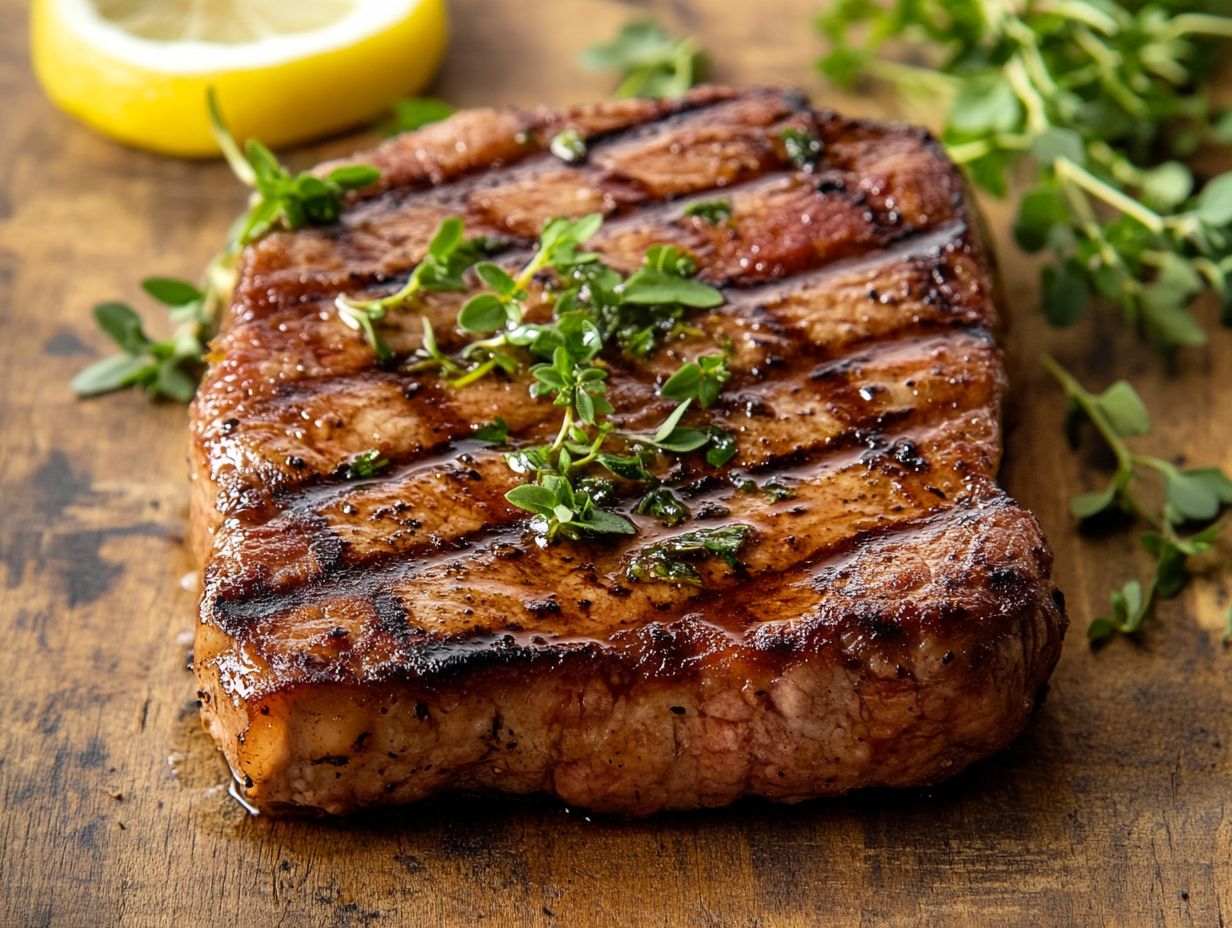How to Achieve the Perfect Grill Marks
Grill marks are not merely a feast for the eyes; they signify expertly cooked food that excites the palate and showcases your grilling skills.
In this article, you will delve into the essence of grill marks and uncover the various factors that influence their appearance, including the type of heat source, grill grate selection, and the grilling methods you utilize.
You ll discover invaluable tips for achieving those perfect stripes, along with creative techniques to enhance their visual appeal and common grilling tips to avoid.
Prepare to elevate your grilling skills and leave a lasting impression on your friends and family with delicious summer grilling recipes!
Contents
- Key Takeaways:
- Understanding Grill Marks
- Factors that Affect Grill Marks
- Grill Type and Surface
- Tips for Achieving Perfect Grill Marks
- Preparation and Seasoning
- Placement and Timing
- Techniques for Flipping
- Creative Ways to Create Grill Marks
- Common Mistakes to Avoid
- Frequently Asked Questions
- What is the best way to achieve perfect grill marks?
- What types of grills are best for creating perfect grill marks?
- Is it important to season the grill before cooking to achieve perfect grill marks?
- How can I get perfect grill marks on vegetables and other delicate foods?
- What is the best technique for achieving perfect grill marks on meat?
- How do I prevent grill marks from burning or becoming too dark?
Key Takeaways:

- Understand the basics of grill marks to achieve the perfect sear on your meats.
- The right heat source, grill type, and grilling equipment are crucial for achieving desired grill marks.
- Proper preparation, seasoning, placement, and flipping techniques lead to Instagram-worthy grill marks.
- Get creative with grill presses, skewers, and different cuts of meat for unique grill marks.
- Avoid overcrowding the grill and let it preheat for best results.
Understanding Grill Marks
Mastering grill marks will take your grilling game to the next level! These distinctive markings not only elevate the visual appeal of your grilled meats but also signal the successful application of techniques that unleash deep, rich flavors.
Whether you’re grilling a perfect ribeye steak or vibrant vegetables, mastering the best grilling techniques for beginners to achieve those diamond-shaped grill marks showcases your skill in heat management.
In the realm of outdoor cooking, grill marks embody both aesthetic charm and cooking goals. They represent the harmonious blend of art and science that defines BBQ culture, as highlighted by grilling experts like Ray Lampe and Abigail Abesamis Demarest.
What are Grill Marks?
Grill marks are those distinctive lines and patterns that adorn the surface of perfectly grilled meat, serving as a signature of your grilling prowess.
These striking impressions are created through a chemical reaction that occurs when food is cooked at high heat, giving it a nice color and flavor. Typically, this happens when the surface of the meat reaches a specific temperature between 300 and 500 degrees Fahrenheit.
You can achieve these impressive marks on various meats steaks, chicken, and even vegetables depending on your cooking techniques, whether you re using direct grilling or indirect heat. Mastering grill temperature is essential; if it s too low, the meat might just steam, and if it s too high, you risk incinerating it, leading to charred remnants instead of the desired elegance.
Factors that Affect Grill Marks
Several critical factors influence the quality and appearance of grill marks when you re grilling, including the type of grill you choose, the heat source, and your temperature settings. Whether you opt for charcoal or gas, each grill type imparts unique characteristics to the meat, ultimately affecting how those grill marks develop.
Choosing the right grill grates and expertly managing the heat are pivotal steps in achieving those coveted sear patterns that signify a masterful grilling technique.
Heat Source and Temperature
The heat source and temperature are pivotal when it comes to achieving those coveted grill marks on your meat. They directly influence how evenly and effectively your food cooks.
Different heat sources, like charcoal and gas, can dramatically alter both the cooking time and the visual allure of your finished dish. Charcoal, with its intense and concentrated heat, often delivers deeper grill marks and a delightful smoky flavor, making it a go-to choice for many traditionalists. In contrast, gas grills offer precise temperature control, allowing you to create a more consistent cooking atmosphere.
For optimal searing, aim for a temperature range of 450 F to 600 F, which may vary depending on the type of meat you re grilling. By mastering temperature control, you not only enhance the appearance of those grill marks but also elevate the overall flavor profile, ensuring your meat is not just beautifully presented but also irresistibly delicious.
Grill Type and Surface

The type of grill and its surface play a pivotal role in shaping the quality of coveted grill marks. There are various options available, including charcoal and gas grills. Each method offers unique benefits, catering to your cooking style.
Charcoal grills are celebrated for their rich, smoky flavor and can create distinct grill marks due to the high heat from burning coal. Gas grills provide a consistent temperature for precise cooking but may result in less pronounced grill marks.
The materials of your grill grates also impact performance. Cast iron grates excel in heat retention and deliver excellent sear marks, while stainless steel grates simplify cleanup but struggle to achieve restaurant-quality lines on your meats.
Tips for Achieving Perfect Grill Marks
You can achieve stunning grill marks that wow your guests with the right techniques! For instance, knowing how to grill the perfect steak every time requires thoughtful food preparation, effective seasoning, and precise timing and placement on the grill.
Whether you’re just starting out or a seasoned pro, these tips will elevate your outdoor cooking experience and help you craft enticing diamond-shaped marks.
Preparation and Seasoning
Preparation and seasoning are the cornerstones of grilling that elevate flavor and presentation while influencing grill marks.
Choosing quality cuts, marinating with intention, and using the right blend of spices can transform your grilling experience. Letting the meat rest after marinating allows flavors to penetrate deeply, ensuring a richer taste.
Incorporating butter and clarified butter is essential. These add luxurious richness and help achieve coveted grill marks as the fats lock in moisture and promote caramelization over high heat.
Placement and Timing
Proper food placement and timing are key for mastering grilling, significantly impacting grill marks and overall cooking performance.
Arranging meat and vegetables with appropriate spacing allows for effective air circulation, ensuring even cooking. Pay attention to the size of various cuts; thicker cuts need more time, while thinner slices may require just a brief encounter with the heat.
Using a mix of direct and indirect grilling techniques enhances your grilling. Direct grilling cooks food over the flame, while indirect grilling uses a cooler side of the grill. Also, remember to use separate utensils for raw and cooked foods to prevent cross-contamination, which is the transfer of harmful bacteria from raw to cooked food.
Techniques for Flipping
Mastering the art of flipping meat is essential for achieving flawless grill marks, ensuring even cooking while preventing sticking to the grate.
Using proper grilling tools like long-handled spatulas or tongs enhances your experience, allowing for a confident and precise flip.
Timing is crucial; wait for that moment when the meat releases from the grate to prevent tearing and maintain surface integrity.
These flipping techniques enhance visual appeal and significantly impact the overall taste and juiciness of your grilled dishes. Attention to detail will elevate your barbecuing skills and impress your guests with beautifully cooked meals.
Creative Ways to Create Grill Marks

Get ready to wow your friends and family with jaw-dropping grill marks that will make your meals unforgettable! Exploring creative methods to achieve perfect grill marks can truly elevate your outdoor cooking experience, turning ordinary meals into visually stunning dishes that will leave everyone in awe.
By incorporating tools such as grill presses or skewers, you can enhance the presentation of your grilled creations. Experimenting with various cuts of meat opens up a world of unique grill mark patterns, enriching your cooking repertoire.
Using Grill Presses or Skewers
Using grill presses or skewers can elevate your grilling game, giving your meats those enviable professional-looking grill marks that enhance both presentation and texture. By applying consistent heat with a grill press, you ensure that your meat cooks evenly while achieving those coveted sear lines that scream deliciousness.
Skewers not only hold your cuts together but also maximize surface area exposure to heat, ensuring a uniform cooking experience. When you’re on the hunt for a grill press, choose one with a heavy cast iron construction for superior heat retention, and consider the grilling grate selection to further optimize your cooking experience.
For the best results, preheat your grill and let the meat sear undisturbed, allowing those stunning grill marks to develop beautifully.
Experimenting with Different Cuts of Meat
Experimenting with different cuts of meat is an exhilarating way to uncover new flavors and textures. Each cut carries its own unique characteristics, inviting you to try new cooking techniques on your cooking journey.
Whether you crave the tenderness of a filet mignon or the robust flavor of a flank steak, understanding how to prepare each type properly can elevate your grilling experience. Some cuts may shine when marinated to accentuate their natural flavors, while others might thrive with a quick cooking method over high heat to achieve those sought-after sear marks.
By mastering the art of grilling a variety of meats, you can transform an ordinary meal into an extraordinary feast.
Common Mistakes to Avoid
Avoiding common mistakes is essential for achieving flawless grill marks and ensuring a successful grilling experience. These errors can undermine both the quality of your meat and your grilling confidence.
Overcrowding the grill may lead to uneven cooking and those coveted grill marks slipping through your fingers. Not letting the grill preheat can result in disappointing outcomes.
Embrace these principles, and you ll elevate your grilling game to a new level. Don t let these mistakes ruin your grilling fun! Take action to ensure you’re serving up perfect meals every time.
Overcrowding the Grill
Overcrowding the grill is a common misstep that can interfere with achieving those coveted grill marks and disrupt the entire grilling experience. When your grill is packed to the brim, this leads to uneven cooking and extends cooking times significantly, as the heat struggles to circulate effectively.
This overcrowding traps moisture, thwarting your quest for that perfect sear and resulting in a texture that s far from ideal. It also raises food safety concerns, as managing too many items tightly packed together can lead to improper handling.
To avoid these pitfalls, try organizing your food in batches, utilize different heat zones on the grill, and plan where to place each item for optimal efficiency. This approach transforms grilling into a pleasurable and efficient endeavor, ensuring both quality and safety remain intact.
Not Letting the Grill Preheat

Don t skip the preheating! It s key to getting those perfect grill marks on your meat.
When your grill hits the right temperature before you add food, you ensure striking grill marks and boost cooking performance. Proper preheating helps proteins sear quickly, locking in moisture and enhancing flavor.
It’s also vital for food safety; cooking at safe temperatures minimizes contamination risks.
To check if your grill is ready, hold your hand a few inches above the grates. If you can t keep it there for more than two seconds, the grill is perfect for cooking.
Frequently Asked Questions
What is the best way to achieve perfect grill marks?
To get perfect grill marks, make sure your grill is preheated to a high temperature. Also, use a clean and well-oiled cooking surface.
What types of grills are best for creating perfect grill marks?
Charcoal grills, gas grills, and outdoor griddles all work great for achieving perfect grill marks.
Is it important to season the grill before cooking to achieve perfect grill marks?
Yes, season your grill with oil or non-stick spray before cooking. This prevents food from sticking and enhances the grill marks.
How can I get perfect grill marks on vegetables and other delicate foods?
For delicate foods, use a grill basket or wrap the food in foil with small holes. This helps create those nice grill marks.
What is the best technique for achieving perfect grill marks on meat?
The best way to get perfect grill marks on meat is to place it at a 45-degree angle on the grill, cook for a few minutes, and then rotate it 90 degrees for a crosshatch pattern. For more tips, check out the best ways to cook steak on a grill.
How do I prevent grill marks from burning or becoming too dark?
Keep an eye on your food to prevent dark grill marks. If needed, move the food to a cooler part of the grill.






